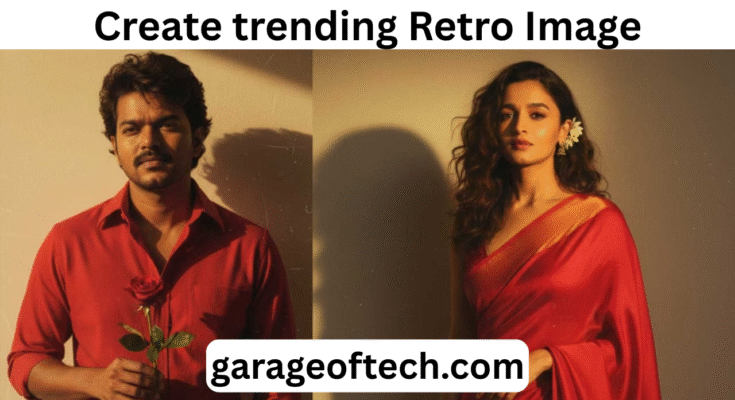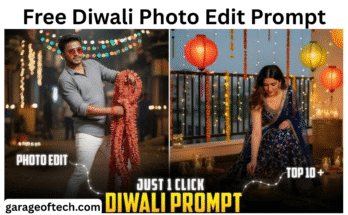Retro-style imagery has always carried a magnetic pull. It is not just about looking back but about re-experiencing moments that feel familiar, cinematic, and timeless. A neon glow spilling across chrome, or the warmth of tungsten light reflecting on vintage fabric, can instantly place the viewer in a different era. With the latest apps such as Gemini, it is now possible to transform digital prompts into photo-perfect retro visuals that feel both nostalgic and hyper-realistic. These tools do not just imitate retro; they allow creators to merge memory with fidelity, making the past visible in today’s visual language.
Defining Retro Beyond Aesthetic
Retro must be understood as more than dust, scratches, or faded tones. It is not about layering filters on an image; it is about recreating cultural depth. A true retro image carries the spirit of its era through objects, typography, fashion, and even film stock characteristics. Gemini allows creators to infuse prompts with this cultural weight, ensuring outputs don’t look like artificial throwbacks but authentic reconstructions of the past. The goal is to translate history into mood and material, not to apply generic filters.
Building Prompt Narratives for Retro
The strength of a retro render lies in narrative-driven prompting. Instead of giving flat instructions like “old car,” a more evocative description would be “1960s chrome body reflecting neon diner lights under rainy asphalt.” This approach defines not just the object but also the light, atmosphere, and context of the scene. Gemini thrives on prompts that combine subject, lighting, and cultural details, resulting in cinematic compositions that blend detail with atmosphere. The richer the description, the closer the output feels to an authentic retro movie still.
Material Fidelity in Retro Design
Retro is communicated most strongly through material realism. Surfaces like cracked leather seats, dusty vinyl grooves, brushed aluminum radios, and worn cotton fabrics all act as time markers. Gemini uses layered diffusion to replicate these tactile materials convincingly. By highlighting specific surface qualities in prompts, creators can ensure the generated image feels not just retro in appearance, but retro in touch and presence. This material fidelity persuades the eye that the artifact belongs to its referenced decade.
Cinematic Lighting for Nostalgia
Lighting is central to retro authenticity. Tungsten warmth, CRT glow, halogen diffusion, and neon highlights all help evoke the signature look of specific eras. Gemini interprets such descriptors precisely, shaping shadow tones and light spill in ways that resonate as vintage. For example, describing “moody amber halogen shadows” paired with reflective chrome ensures the image glows with cinematic nostalgia while retaining hyper-real clarity. Retro lighting is not about looking old—it’s about remembering light as it once was experienced.
Color Palettes that Signal Time
Every decade carries its own color language. The pastels of the 1980s, the saturated reds of Kodachrome film, and the muted earthy tones of the 1970s all immediately locate an image within a cultural timeframe. Gemini respects these palette cues, integrating slight fading, tone curves, and film-like grain into its renderings. Color in retro work should never be random; it must be anchored to historical palettes that resonate with memory. This ensures hyper-realism emerges not from flawlessness but from accurate storytelling through color.
Texture Layers for Convincing Realism
Retro realism thrives on imperfection. The scratches on jukebox chrome, a faint burn mark on velvet seating, or cigarette stains on a tabletop are not flaws—they are storytelling devices. Gemini can replicate these micro-textures when prompted, layering imperfections in ways that feel organic. This prevents the scene from sliding into cliché while adding tactile truth. A carefully built texture vocabulary transforms a synthetic retro render into one that feels lived-in and believable.
Framing with Retro Composition
Composition defines how an era is remembered. Retro authenticity does not come only from the subject but from how it is framed. A wide diner booth, a Polaroid tilt, or a centered arcade cabinet speaks directly to the viewer’s memory of period photography. Gemini can absorb such compositional cues, integrating them into generated results. By guiding the tool with era-specific framing styles, the final output echoes how cameras of that time captured the world.
Depth of Field and Film Simulation
Retro cinema is inseparable from its visual flaws. Shallow depth of field from vintage lenses, halation around bright lights, lens flares, or even subtle gate weave—all these imperfections reinforce believability. Gemini allows such effects to be encoded into prompts, enriching the illusion of film. Grain, focus shifts, and soft halation are not distractions but essential signals of authenticity. By embracing these constraints, the image gains the mood and tactile quality of archival footage reborn in HD.
Iteration for Commercial Quality
Commercial retro visuals require iteration. A single prompt rarely delivers the perfect blend of mood, lighting, and micro-texture. Iterative refinement—testing descriptors, rebalancing details, and pushing lighting conditions—ensures outputs that hold up in professional campaigns. For advertisers, this process yields visuals strong enough to sustain nostalgic resonance while meeting modern standards of clarity and engagement. Retro, when polished through multiple iterations, can become a powerful commercial trigger for emotional buying decisions.
Monetizing Retro Visuals
Retro visuals have proven commercial value. They are used in vinyl reissues, boutique fashion campaigns, hospitality branding, and retro-themed digital products. Their strength lies in emotional familiarity, which translates into higher ad engagement and click-through rates. Gemini ensures scalability, allowing assets to be produced for web, mobile, and print while maintaining consistent quality. Brands benefit from the ability to deploy nostalgia-driven campaigns across multiple channels without losing the retro charm that fuels conversions.
Ethical Boundaries in Retro Creation
While retro imagery inspires nostalgia, it also carries responsibility. Misrepresenting or trivializing history risks cultural backlash. Creators must balance commercial storytelling with respect for historical accuracy. Gemini provides the tools to generate authentic retro styles, but the burden lies with creators to ensure eras are referenced with care. Ethical retro creation safeguards both brand integrity and audience trust, allowing nostalgia to be celebrated without distortion.
Prompts for Retro Image Creation
Prompt for Boy – 1:
Convert it into a retro vintage grainy but bright image of the man from the reference picture. Keep the facial features the same. The man should be draped in perfect plain retro attire stylish collared shirt in an red color and pant in white color with rose flower in his hand near heart, evoking a Pinteresty aesthetic retro vibe. It must feel like a 90s movie with dark brown wavy curly hair, subtly tousled. The environment should be romanticizing and windy. The man is standing against a solid wall with deep shadows and contrast drama, creating a mysterious and artistic atmosphere. The lighting is warm with golden tones, evoking a sunset or golden hour glow. The background is minimalist and slightly textured. The expression on his face is moody, calm yet happy and introspective. Make it in HD quality. You need to preserve the same face from the reference.
Prompt for Boy – 2:
A retro vintage grainy yet bright image of the uploaded person, styled in a perfect Pinteresty brown retro men’s outfit – think loose trousers, tucked white shirt with brown jacket with timeless 90s charm. His hair is jet black, styled in a slightly messy, cinematic way. He is standing against a solid textured wall, with deep shadows and dramatic contrast, evoking a mysterious and artistic aura. The lighting is warm with a golden-hour glow, casting soft highlights across his face. The environment feels slightly windy, adding movement to the scene, while the background remains minimalist with subtle texture. His expression is moody yet calm, a mix of happiness and introspection, as if lost in thought. The whole frame should feel like a 90s romantic movie still, aesthetic, cinematic, and timeless.
Prompt for Boy – 3:
Create a retro,vintage-inspired image-grainy yet bright-based on the reference picture. The boy should be wearing in a white shirt with small brown flower prints,paired & plated beige pant styled in a Pinterest-inspired aesthetic. The vibe must capture the essence of a 90s movie dark-brown-haired baddie,romantic atmosphere.He is sitting on a wooden bench as a few leaves blow in the air,while dramatic contrasts add mystery and artistry tothe scene,create moody yet enchanting, You need to preserve the same face from the reference.
Prompt for Boy – 4:
To take this young Indian boy photo reference and generate a retro,vintage-inspired image-grainy effectively and cinematic look he have skinny personality he is wearing un button lite colour pink shirt and and cream colour cargo pant and he wearing watch small silver chain his neck he slidely sitting on a boat and giving best pose the boat in a river the river Full of Lotus flowers and there is a small old style radio in the boat and he enjoying music, he is wearing white colour stylish shoes, The vibe must capture the essence of a 90s movie romantic atmosphere, You need to preserve the same face from the reference.
Prompt for Boy – 5:
Create Image of the reference picture A cinematic outdoor portrait of a stylish young man is confidently standing against a black Yamaha RX100 motorcycle. He is wearing a white button-up shirt, light brown trousers, and white loafers, accessorized with a wristwatch and a bracelet and sunglasses. The background features overgrown greenery and a weathered concrete wall, giving a rustic, urban vibe. The atmosphere is moody with warm, vintage tones, creating a retro aesthetic. His expression is serious and composed, evoking a sense of mystery and rugged charm. And keep the same face from my uploaded Reference Selfie, same eyes, same nose, same cheeks, same texture.
Prompt for Boy – 6:
A vintage 1970s Bollywood-inspired cinematic photograph of a stylish man sitting casually on the hood of a classic car. He wears a cream 143 pinstriped blazer, cream bell-bottom trousers, and a dark brown shirt with the top buttons open, paired with polished brown formal shoes, 19 exuding a confident mafia-style charisma. The car has chrome details, wide whitewall tires, and a polished metallic body reflecting golden sunlight. In the background, tall lush green trees and manicured hedges frame the scene. The photo is captured in warm, grainy tones of a 1970s film camera, with soft focus and 41 cinematic depth of field, giving a retro, cinematic, timeless Bollywood vibe.
Prompt for Girl – 1:
Convert it in a retro vintage grainy but bright image of the reference picture keep the facial features same but draped in a perfect plain banarasi saree red color Pinteresty aesthetic retro saree. It must feel like a 90s movie dark brown wavy curly hair with a small flower tucked visibly into her curls and romanticising windy environment. The girl is standing against a solid wall deep shadows and contrast drama, creating a mysterious and artistic atmosphere where the lighting is warm with a golden tones of evoking a sunset or golden hour glow. The background is minimalist and slightly textured the expression on her face is moody, calm yet happy and introspective. Make it in HD quality. You need to preserve same face.
Prompt for Girl – 2:
A retro cinematic close-up portrait of a South Indian girl in a muted cotton saree, based on the reference picture, holding a pink lotus gently near her face. Her wavy dark hair flows softly, with jasmine flowers tucked in visibly. The blurred pond and lotus leaves form the background. The image has dreamy vintage lighting, deep shadows, grainy film texture, and a nostalgic 90s cinematic mood.
Prompt for Girl – 3:
A full body, hyper-realistic 8K portrait, height 5ft 5inch, face unchanged from the reference picture, she is a well groomed with straight to minimal curly black hair, wearing a yellow chiffon saree translucent floral saree, showing an Indian singer sitting barefoot on the edge of a rustic boat in calm blue waters. Lotus in the water, romantically environment.
Prompt for Girl – 4:
Create a retro, vintage-inspired image – grainy yet bright – based on the reference picture.
The girl should be draped in a perfect off white cotton saree with floral print on it, Pinterest-style aesthetic saree. The vibe must capture the essence of a 90s movie dark brown haired baddie, with silky hair and a small flower tucked visibly into her hair back side, enhanced by a windy, romantic atmosphere, creating a moody yet enchanting cinematic effect. Make a pose like she is reading a book sitting on a bench in a garden. The image has dreamy vintage lighting, deep shadows, grainy film texture, and a nostalgic 90s cinematic mood.



